YAMAHA SLIDER 50 2003 Workshop Manual
Manufacturer: YAMAHA, Model Year: 2003, Model line: SLIDER 50, Model: YAMAHA SLIDER 50 2003Pages: 80, PDF Size: 2.76 MB
Page 51 of 80
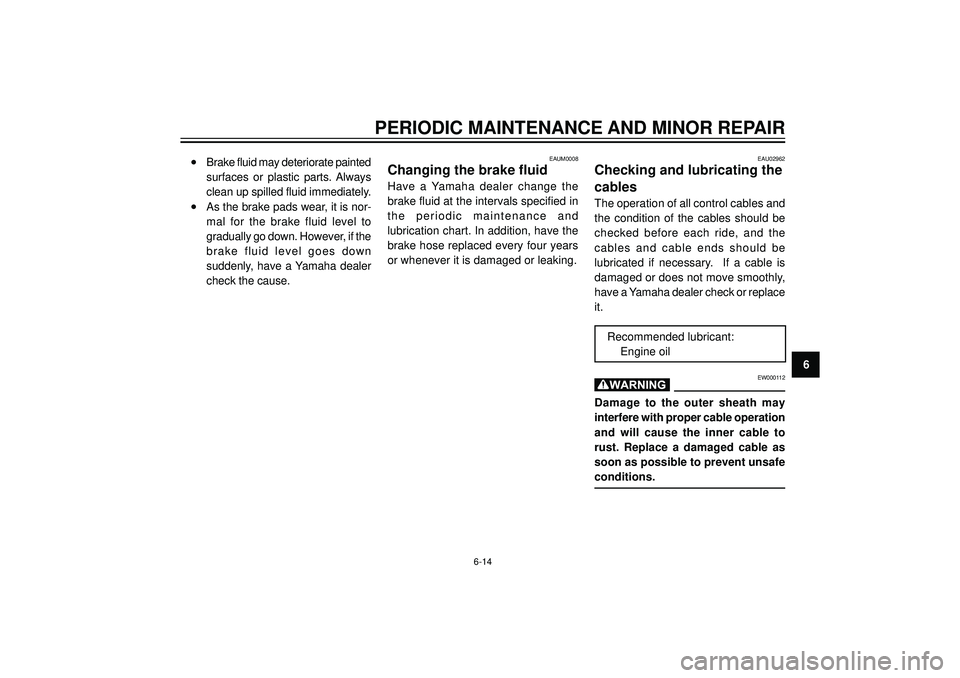
PERIODIC MAINTENANCE AND MINOR REPAIR
6
EAUM0008
Changing the brake fluid
Have a Yamaha dealer change the
brake fluid at the intervals specified in
the periodic maintenance and
lubrication chart. In addition, have the
brake hose replaced every four years
or whenever it is damaged or leaking.
EAU02962
Checking and lubricating the
cables
The operation of all control cables and
the condition of the cables should be
checked before each ride, and the
cables and cable ends should be
lubricated if necessary. If a cable is
damaged or does not move smoothly,
have a Yamaha dealer check or replace
it.
Recommended lubricant:
Engine oil
EW000112
Damage to the outer sheath may
interfere with proper cable operation
and will cause the inner cable to
rust. Replace a damaged cable as
soon as possible to prevent unsafe
conditions.
6-14
•Brake fluid may deteriorate painted
surfaces or plastic parts. Always
clean up spilled fluid immediately.
•As the brake pads wear, it is nor-
mal for the brake fluid level to
gradually go down. However, if the
brake fluid level goes down
suddenly, have a Yamaha dealer
check the cause.
Page 52 of 80

PERIODIC MAINTENANCE AND MINOR REPAIR
6
EAU04034
Checking and lubricating the
throttle grip and cable
The operation of the throttle grip should
be checked before each ride. In addi-
tion, the cable should be lubricated or
replaced at the intervals specified in the
periodic maintenance chart.
ZAUM0061
EAU03118
Lubricating the front and rear
brake levers
The pivoting points of the front and rear
brake levers must be lubricated at the
intervals specified in the periodic main-
tenance and lubrication chart.
Recommended lubricant:
Lithium-soap-based grease
(all-purpose grease)
EAU04123
Checking and lubricating the
centerstand
The operation of the centerstand should
be checked before each ride, and the
pivots and metal-to-metal contact sur-
faces should be lubricated if necessary.
EWA00055
If the centerstand does not move up
and down smoothly, have a Yamaha
dealer check or repair it.
Recommended lubricant:
Lithium-soap-based grease
(all-purpose grease)
1
ZAUM0455
1. Centerstand
6-15
Page 53 of 80

PERIODIC MAINTENANCE AND MINOR REPAIR
6
EAU02939
Checking the front fork
The condition and operation of the front
fork must be checked as follows at the
intervals specified in the periodic main-
tenance and lubrication chart.
To check the condition
EW000115
Securely support the scooter so that
there is no danger of it falling over.
Check the inner tubes for scratches,
damage and excessive oil leakage.To check the operation
1. Place the scooter on a level sur-
face and hold it in an upright po-
sition.
2. While applying the front brake,
push down hard on the
handlebars several times to check
if the front fork compresses and
rebounds smoothly.
EC000098
If any damage is found or the front
fork does not operate smoothly,
have a Yamaha dealer check or
repair it.
ZAUM0159
EAU00794
Checking the steering
Worn or loose steering bearings may
cause danger. Therefore, the operation
of the steering must be checked as
follows at the intervals specified in the
periodic maintenance and lubrication
chart.
1. Place a stand under the engine
to raise the front wheel off the
ground.
EW000115
Securely support the scooter so that
there is no danger of it falling over.
6-16
Page 54 of 80
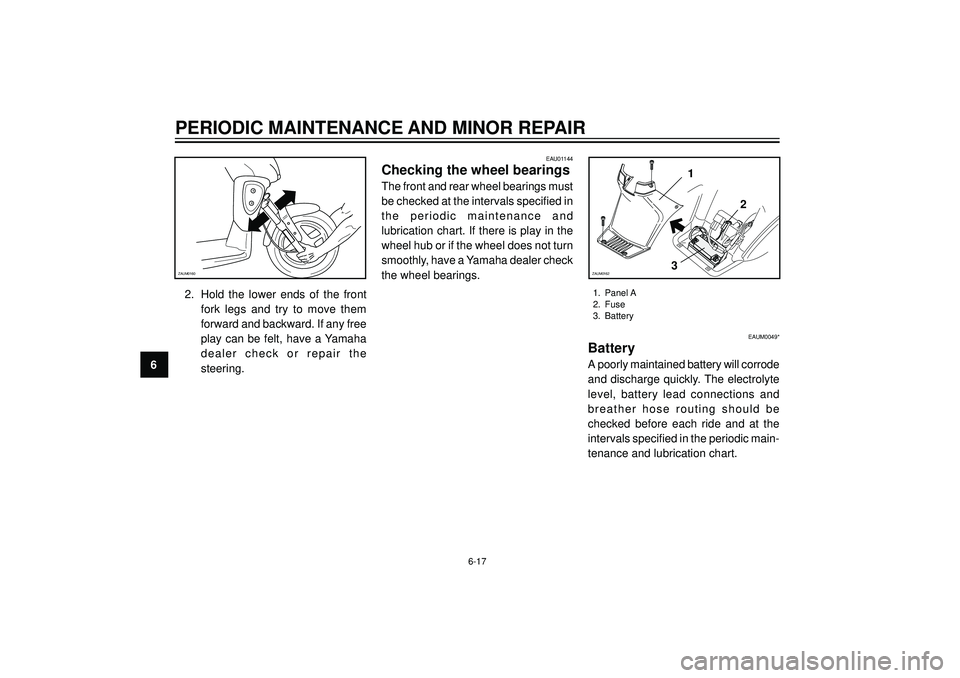
PERIODIC MAINTENANCE AND MINOR REPAIR
62. Hold the lower ends of the front
fork legs and try to move them
forward and backward. If any free
play can be felt, have a Yamaha
dealer check or repair the
steering.
ZAUM0160
EAU01144
Checking the wheel bearings
The front and rear wheel bearings must
be checked at the intervals specified in
the periodic maintenance and
lubrication chart. If there is play in the
wheel hub or if the wheel does not turn
smoothly, have a Yamaha dealer check
the wheel bearings.
32 1ZAUM0162
6-171. Panel A
2. Fuse
3. Battery
EAUM0049*
Battery
A poorly maintained battery will corrode
and discharge quickly. The electrolyte
level, battery lead connections and
breather hose routing should be
checked before each ride and at the
intervals specified in the periodic main-
tenance and lubrication chart.
Page 55 of 80
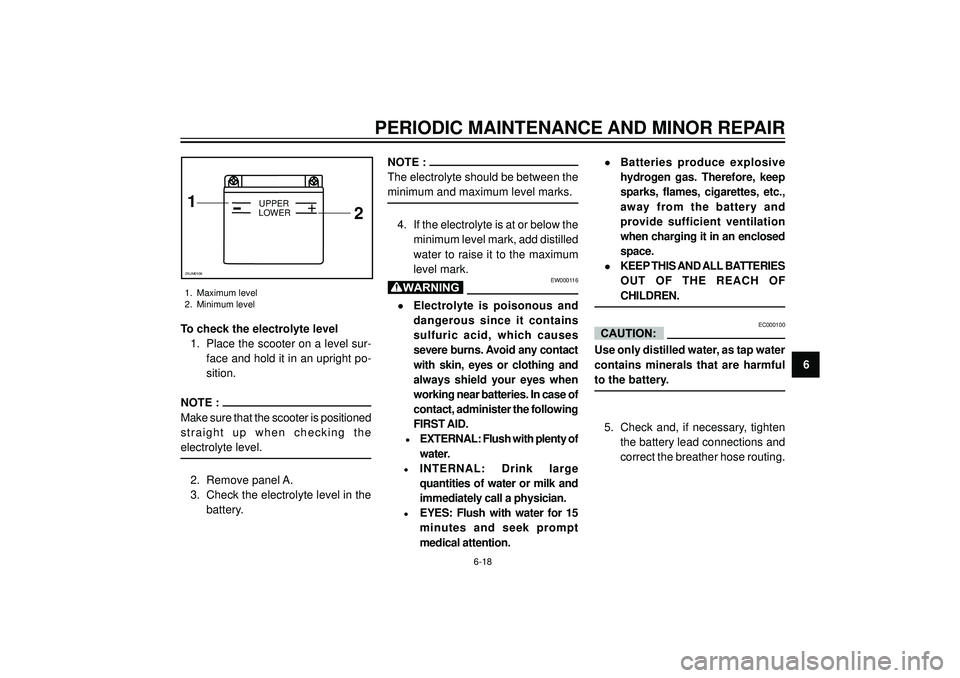
PERIODIC MAINTENANCE AND MINOR REPAIR
6
1
2+UPPER
LOWER
ZAUM0106
1. Maximum level
2. Minimum level
6-18
To check the electrolyte level
1. Place the scooter on a level sur-
face and hold it in an upright po-
sition.
NOTE :
Make sure that the scooter is positioned
straight up when checking the
electrolyte level.
2. Remove panel A.
3. Check the electrolyte level in the
battery.
NOTE :
The electrolyte should be between the
minimum and maximum level marks.
4. If the electrolyte is at or below the
minimum level mark, add distilled
water to raise it to the maximum
level mark.
EW000116
•Electrolyte is poisonous and
dangerous since it contains
sulfuric acid, which causes
severe burns. Avoid any contact
with skin, eyes or clothing and
always shield your eyes when
working near batteries. In case of
contact, administer the following
FIRST AID.
•EXTERNAL: Flush with plenty of
water.
•INTERNAL: Drink large
quantities of water or milk and
immediately call a physician.
•EYES: Flush with water for 15
minutes and seek prompt
medical attention.
•Batteries produce explosive
hydrogen gas. Therefore, keep
sparks, flames, cigarettes, etc.,
away from the battery and
provide sufficient ventilation
when charging it in an enclosed
space.
•KEEP THIS AND ALL BATTERIES
OUT OF THE REACH OF
CHILDREN.
EC000100
Use only distilled water, as tap water
contains minerals that are harmful
to the battery.
5. Check and, if necessary, tighten
the battery lead connections and
correct the breather hose routing.
Page 56 of 80
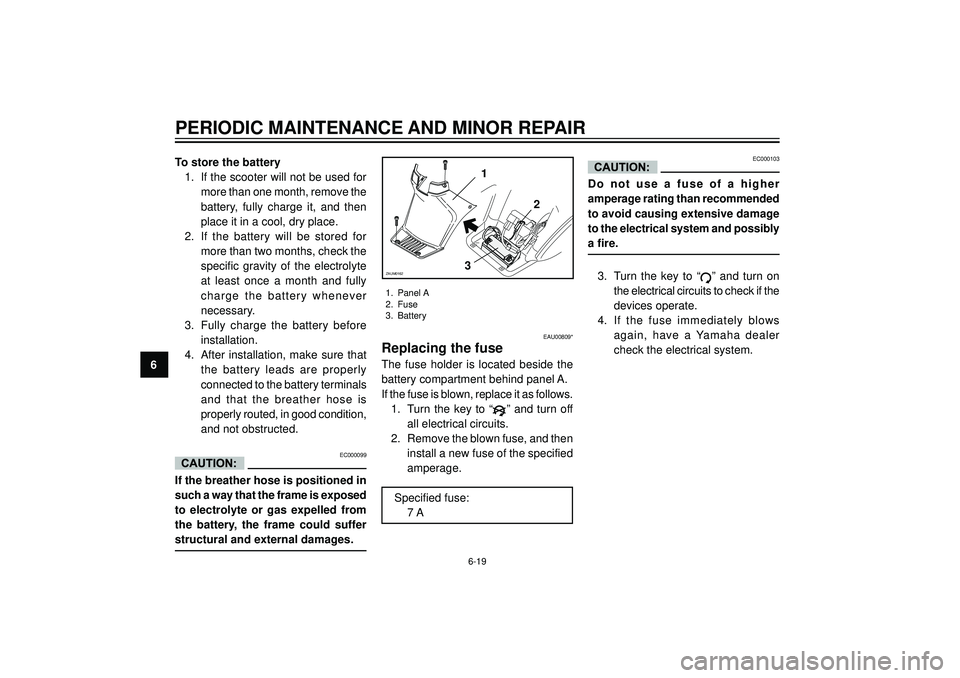
PERIODIC MAINTENANCE AND MINOR REPAIR
6
1. Panel A
2. Fuse
3. Battery
6-19
32 1ZAUM0162
To store the battery
1. If the scooter will not be used for
more than one month, remove the
battery, fully charge it, and then
place it in a cool, dry place.
2. If the battery will be stored for
more than two months, check the
specific gravity of the electrolyte
at least once a month and fully
charge the battery whenever
necessary.
3. Fully charge the battery before
installation.
4. After installation, make sure that
the battery leads are properly
connected to the battery terminals
and that the breather hose is
properly routed, in good condition,
and not obstructed.
EC000099
If the breather hose is positioned in
such a way that the frame is exposed
to electrolyte or gas expelled from
the battery, the frame could suffer
structural and external damages.
EAU00809*
Replacing the fuse
The fuse holder is located beside the
battery compartment behind panel A.
If the fuse is blown, replace it as follows.
1. Turn the key to “
” and turn off
all electrical circuits.
2. Remove the blown fuse, and then
install a new fuse of the specified
amperage.
Specified fuse:
7 A
EC000103
Do not use a fuse of a higher
amperage rating than recommended
to avoid causing extensive damage
to the electrical system and possibly
a fire.
3. Turn the key to “
” and turn on
the electrical circuits to check if the
devices operate.
4. If the fuse immediately blows
again, have a Yamaha dealer
check the electrical system.
Page 57 of 80

PERIODIC MAINTENANCE AND MINOR REPAIR
6
EAUM0072
Replacing a headlight bulb
1. Remove front cover by removing
the screws.
2. Remove the headlight coupler.3. Remove the headlight bulb holder
by turning it 1/4 turn
counterclockwise.
4. Remove the defective bulb.
EW000119
Headlight bulbs get very hot.
Therefore, keep flammable products
away from a lit headlight bulb, and
do not touch the bulb until it has
cooled down.
5. Place a new headlight bulb into
position, and then secure it with
the bulb holder.
1. Screw (x4)1. Headlight bulb holder
1
ZAUM0530
6-20
1
1
ZAUM0529
6. Connect the headlight coupler and
install the front cover.
EC000105
Do not touch the glass part of the
headlight bulb to keep it free from
oil, otherwise the transparency of
the glass, the luminosity of the bulb,
and the bulb life will be adversely
affected. Thoroughly clean off any
dirt and fingerprints on the headlight
bulb using a cloth moistened with
alcohol or thinner.
Page 58 of 80

PERIODIC MAINTENANCE AND MINOR REPAIR
6
2 1
ZAUM0531
1
2
ZAUM0532
1. Lens
2. Screw (x2)
6-21
EAU01623
Replacing the tail/brake light
bulb
1. Remove the tail/brake light lens by
removing the screws.
2. Remove the defective bulb by
pushing it in and turning it
counterclockwise.
3. Insert a new bulb into the socket,
push it in, and then turn it
clockwise until it stops.
4. Install the lens by installing the
screws.
EC000108
Do not overtighten the screws,
otherwise the lens may break.
EAU03497
Replacing a turn signal light
bulb
1. Remove the turn signal light lens
by removing the screw.
2. Remove the defective bulb by
pushing it in and turning it
counterclockwise.
3. Insert a new bulb into the socket,
push it in, and then turn it
clockwise until it stops.
4. Install the lens by installing the
screw.
ECA00065
Do not overtighten the screw,
otherwise the lens may break.
EAU01008
Troubleshooting
Although Yamaha scooters receive a
thorough inspection before shipment
from the factory, trouble may occur
during operation. Any problem in the
fuel, compression, or ignition systems,
for example, can cause poor starting
and loss of power.
The following troubleshooting chart
represents a quick and easy procedure
for checking these vital systems
yourself. However, should your scoo-
ter require any repair, take it to a
Yamaha dealer, whose skilled
technicians have the necessary tools,
experience, and know-how to service
the scooter properly.
Use only genuine Yamaha replacement
parts. Imitation parts may look like
Yamaha parts, but they are often
inferior, have a shorter service life and
can lead to expensive repair bills.
1. Screw
2. Lens
Page 59 of 80
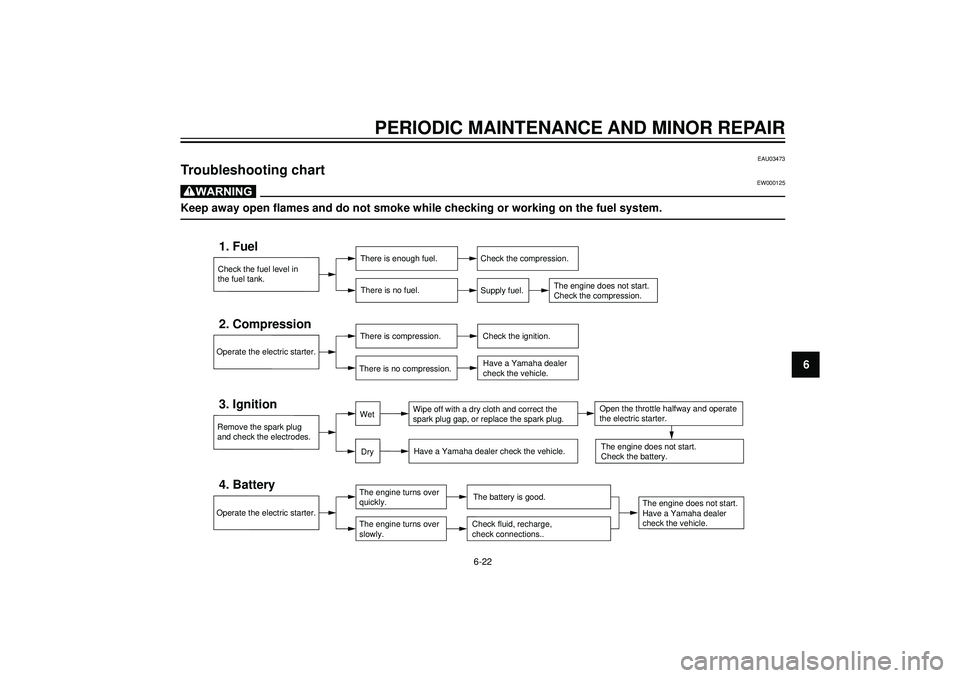
PERIODIC MAINTENANCE AND MINOR REPAIR
6
6-22
EAU03473
Troubleshooting chartEW000125
Keep away open flames and do not smoke while checking or working on the fuel system.
Check the fuel level in
the fuel tank.
1. FuelThere is enough fuel.
There is no fuel.Check the compression.
Supply fuel.
The engine does not start.
Check the compression.
Operate the electric starter.
2. CompressionThere is compression.
There is no compression.Check the ignition.
Have a Yamaha dealer
check the vehicle.
Remove the spark plug
and check the electrodes.
3. IgnitionWipe off with a dry cloth and correct the
spark plug gap, or replace the spark plug.
Have a Yamaha dealer check the vehicle.
The engine does not start.
Have a Yamaha dealer
check the vehicle.
The engine does not start.
Check the battery.
Operate the electric starter.
4. BatteryThe engine turns over
quickly.
The engine turns over
slowly.The battery is good.
Check fluid, recharge,
check connections..
Dry
WetOpen the throttle halfway and operate
the electric starter.
Page 60 of 80
